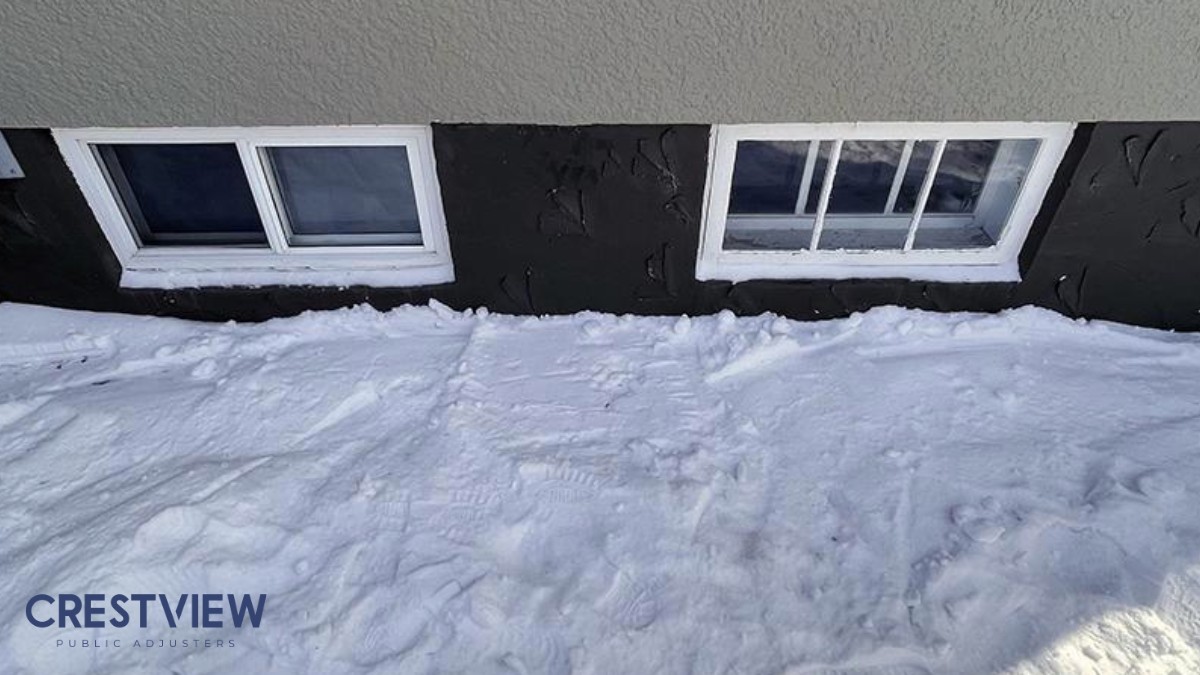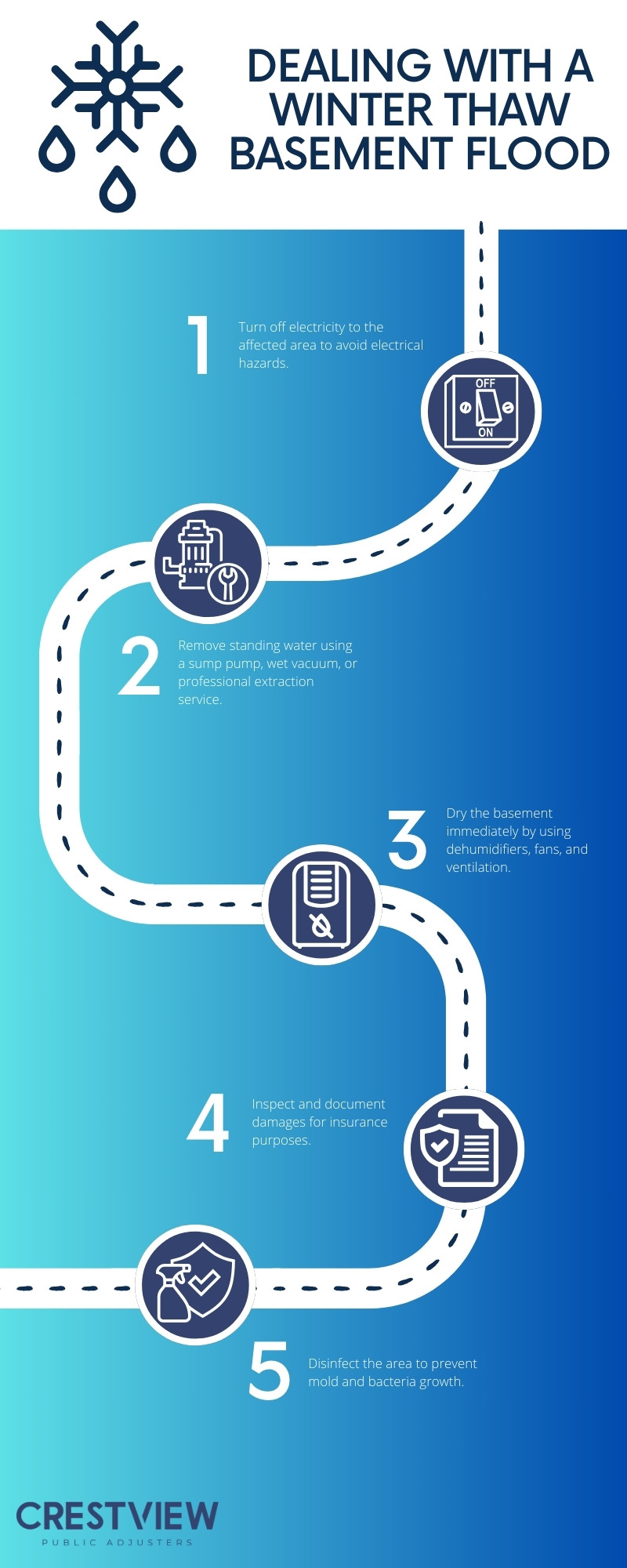Key Points:
- Rapid snowmelt and frozen ground significantly increase the risk of basement flooding during winter thaws.
- Key preventative measures include ensuring proper drainage, sealing foundation cracks, and maintaining sump pumps.
- Policyholders facing winter water damage may benefit from working with public adjusters to navigate insurance claims.
Basement flooding during winter thaws is a serious concern for homeowners, particularly in regions prone to heavy snowfall and fluctuating temperatures. When snow melts rapidly, frozen ground prevents water from being absorbed, leading to an increased risk of flooding. A study by the Federal Emergency Management Agency (FEMA) highlights that over 90% of natural disasters in the U.S. involve some form of flooding, with winter thaws being a significant contributing factor.
Why Do Basements Flood During Winter Thaws?
The primary cause of basement flooding during winter thaws is the combination of snowmelt, frozen soil, and inadequate drainage. When temperatures rise suddenly, snow and ice melt faster than the ground can absorb. The water then pools around a home’s foundation, eventually finding its way inside through cracks, gaps, or drainage failures.
Other contributing factors include:
- Blocked or frozen gutters and downspouts – If ice prevents proper drainage, water overflows and seeps into the foundation.
- Poorly graded landscaping – If the ground slopes toward the house instead of away, melting snow directs water toward the basement.
- Malfunctioning sump pumps – If a sump pump fails or lacks capacity, excess water has no way to be discharged.
How to Prevent Basement Flooding in Winter
Preventing basement flooding during winter thaws requires a proactive approach. By taking the right precautions before the snow starts to melt, homeowners can significantly reduce the risk of water damage.
1. Maintain and Clear Gutters and Downspouts
Proper water diversion starts with an efficient gutter system. If gutters and downspouts are clogged or frozen, melting snow will spill over, saturating the ground near your foundation.
- Regularly clean gutters before and during winter to remove leaves, ice buildup, and debris.
- Install gutter guards to prevent excessive ice formation and blockages.
- Ensure downspouts extend at least 6 feet away from the foundation to prevent pooling near basement walls.
2. Inspect and Seal Foundation Cracks
Even the smallest cracks in basement walls and floors can allow water to seep through. As temperatures fluctuate, these cracks can expand, worsening the problem.
- Examine the foundation for visible cracks before winter begins.
- Use waterproof sealants or hydraulic cement to seal small cracks before they turn into major leaks.
Consider professional waterproofing solutions if the basement has a history of water intrusion.

3. Ensure Proper Yard Grading and Drainage
Water should naturally flow away from your home, not toward it. Landscaping plays a critical role in preventing basement flooding during winter thaws.
- Regrade the yard to ensure at least a 5% slope away from the foundation.
- Install French drains or trench drains to redirect excess water.
- Check for standing water or pooling areas around the house and address them before snow melts.
4. Test and Maintain Your Sump Pump
A properly functioning sump pump is one of the most effective defenses against basement flooding. If snowmelt reaches your basement, a sump pump will remove the excess water before it causes major damage.
- Test the pump monthly by pouring water into the sump pit to ensure it activates.
- Check for clogs in discharge pipes and clear any ice buildup.
- Have a backup power source, such as a battery backup or generator, to keep the pump running during winter storms.
5. Install a Backup Drainage System
One layer of protection may not be enough during extreme weather conditions. Homeowners in flood-prone areas should consider additional drainage solutions.
- A secondary sump pump provides redundancy if the primary pump fails.
- A drain tile system helps channel excess water away from the foundation.
- Exterior waterproofing membranes add another barrier against water intrusion.
What to Do If Your Basement Floods During a Winter Thaw
Even with the best preventive measures, basement flooding can still occur, especially during extreme snowmelt events. Acting quickly can minimize damage and prevent mold growth.

Why Working with a Public Adjuster is Critical for Winter Damage Claims
Dealing with insurance claims after basement flooding can be overwhelming. Many policyholders struggle to navigate coverage terms, exclusions, and claim denials. This is where a public adjuster can make all the difference.
Get Expert Help for Winter Flood Damage Claims
At Crestview, we specialize in handling winter damage claims in Florida, New York, and New Jersey. Our team works directly with policyholders to ensure they receive fair settlements for basement flooding and other winter-related damages. We assess losses, negotiate with insurers, and maximize payouts, so you don’t have to go through the process alone.
If winter flooding has affected your home, let Crestview handle the claim process for you. Contact us today for expert assistance in securing the compensation you deserve.

